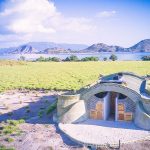We’re always after another challenge, because the challenge makes us better at what we do. — Mike Reynolds
The sun is high in the sky at Gili Kenawa, West Sumbawa in West Nusa Tenggara.
As we approach the shore on board of a small traditional jukung boat, the whole island can be admired in a single glance. The view is picture perfect; a green soft hill overlooks less than 14 hectares of inhabited land surrounded by pristine waters teeming with marine life.
However, we are not here on a snorkeling trip. We came to follow the construction of the first Earthship in Indonesia.
The project is part of EcoRegions Indonesia, a sustainable and comprehensive development program of over 20,000 ha of islands forest, reefs and beaches in Lombok and Sumbawa. The master plan addresses eco-tourism development, environmental performance, the needs of the local community and sustainable economic development, with the aim to create Asia’s largest eco-region. In Gili Kenawa, the partnership between EcoRegions and Earthship plans to jointly create Southeast Asia’s first Earthship Academy and branded Earthship Resort. Starting in December 2016, a minimum of 44 Earthship units will be built under a three-year period.

The idea to use garbage, local and recycled materials to build a self-sufficient building that takes care of its inhabitants and exists in harmony with the surrounding environment is the concept behind the Earthship. The father of the Earthship movement, Mike Reynolds, has been building these passive, off-the-grid, sustainable homes for almost 40 years worldwide, adapting their sustainable design and use to various weather conditions and contexts.
“I think real sustainability involves six aspects of humanity,” the 72-year-old architect said during a break from the construction site.
“First, humans need comfortable shelter that doesn’t use fuel.” he explained. “We all need electricity and water and all societies need to do something with sewage and with the garbage they produce. Last but not least, everybody needs food.” These, he said, are six things that all of humanity has to address to have a life today. “We’re trying to make a building that addresses all of these six things, all the time, all over the world. That’s what this building will be,” Reynolds says.

Brooke, one of the over 50 volunteers as part of the construction team, said the arrival was a bit of a shock.
“The heat, the sun, the people, the enthusiasm. Overwhelming, beautiful,” she said as she wiped off sweat and dust from her smiley face.
“Two weeks into the project, we have adapted and now we are a tight team of sustainable warriors coming from across the world to learn from Mike Reynolds.”
The construction team is completed by the Earthship specialized team and a group of local workers, who will train other local teams for future construction when the volunteers and the Earthship team will be gone.
“This is the first of such buildings in Indonesia,” proudly said Agus, a local worker from Poto Tano and among the first locals to be trained in Earthship construction. “There are old tyres and plastic bottles everywhere, so it’s good to learn how to make strong buildings with this.” he added.
Tires stuffed with compressed soil create mass, plastic and glass bottles isolate the building and decorate it; electrical energy is harnessed from the sun and the wind, water from the rain and the treatment of grey waters, which in turn waters gardens around the Earthship. All the bottles tires and mud turn into a totally sustainable 4-5 star residence.
Inside the building under construction is less than 20 degree Celsius inside, while the outdoor temperature is unbearable.
Brooke explained the mass creates a micro-climate and pipes on the facade absorb external air, which is cooled down as it enters and circulates in the building, creating a natural airflow without the use of conventional air-cooling devices.
A workshop on this breeze-maker system is scheduled for March 2017, when the second stage of the Earthship project will take place.

“I have been living in an Earthship for more than 40 years,” Reynolds said, adjusting his hat under the hot sun.
“My office is an Earthship, my house is an Earthship. When I am hungry, I just go into the Earthships, pick bananas, grapes and I eat. I don’t have utility bills; when it rains, I am happy because I have water. But when it’s not raining I am happy too because I have the sun and sun makes electricity. I know that when I use the toilet, I am making soil for the plants.”
He pointed at the septic tank, a hole dug in the earth also packed with tires stuffed with soil.
“Every part of your daily life routine is contributing to your daily life routine and the Earth. All of a sudden you are in harmony with the Earth, because on the planet there is all the energy we need,” he concluded, and climbed the ladder to finish placing some glass bottles in the top part of the building.
The sun is low on the horizon when the team stops working and gathers in front of the Earthship under construction. Their clothes covered with dirt, they all look tired but happy, their eyes shining under layers of sweat and a red face kissed by the tropical sun. Each one has a different story and background but shares the common dream to spread the culture of sustainable construction and sustainable living.
Read more about the first Earthiship in Indonesia on Margeye!


